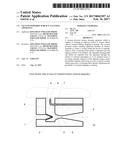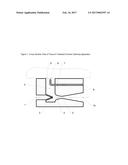Patent application title: VACUUM POWERED SURFACE CLEANING APPARATUS
Inventors:
Jonathan William Smith (Nepean, CA)
Hugh Hunter Chant (Lyn, CA)
Matthew William Smith (Algonquin, CA)
IPC8 Class: AA47L700FI
USPC Class:
1 1
Class name:
Publication date: 2017-02-16
Patent application number: 20170042397
Abstract:
A vacuum powered surface cleaning apparatus which is capable of cleaning
an adjacent surface to remove debris without external leaking, dripping
or misting. The vacuum powered surface cleaning apparatus includes an
eductor assembly to create a vacuum within the device to naturally induce
a flow of cleaning fluid which is imparted onto the adjacent surface to
be cleaned. The expended cleaning fluid and debris are expelled from the
apparatus through the eductor to external atmosphere or to an external
waste or recycling container. Removal of the adjacent surface opens the
internal chamber which causes a loss of partial vacuum which ceases flow
of cleaning fluid, thereby eliminating the possibility of external
dripping or misting.Claims:
1. A vacuum powered surface cleaning apparatus comprising: an enclosed
partial vacuum chamber comprising: a partially enclosed chamber; and an
adjacent surface; and an eductor assembly comprising: an air nozzle; and
an eductor throat; and an eductor outlet; a connecting duct which
connects the eductor assembly to the enclosed partial vacuum chamber; a
compressed air supply; a cleaning fluid supply comprising; an external
cleaning fluid source; and a cleaning fluid flow channel; wherein the
compressed air supply passes through the air nozzle and is converted from
high static pressure to low static pressure and high dynamic pressure,
and the ejected low static pressure air stream enters the eductor throat
inducing a low static pressure within the connecting duct and enclosed
partial vacuum chamber which induces a flow of cleaning fluid from the
cleaning fluid source and through the cleaning fluid flow channel and
imparts the flow of cleaning fluid onto the adjacent surface to be
cleaned, and expended cleaning fluid together with dislodged debris are
expelled from the partial vacuum chamber through the connecting duct and
through the eductor and through the eductor outlet.
2. The vacuum powered surface cleaning apparatus of claim 1, wherein the adjacent surface is of any shape including planar, contoured or irregular.
3. The vacuum powered surface cleaning apparatus of claim 1, wherein the removal of the adjacent surface causes the partial vacuum chamber to become open to atmosphere which ceases the induced flow of cleaning fluid from the cleaning fluid source and cleaning fluid channel.
Description:
CROSS-REFERENCE TO RELATED APPLICATION
[0001] Not Applicable
BACKGROUND OF INVENTION
[0002] This invention pertains to surfaces in industry which are required to be cleaned by flushing and/or diluting with a cleaning fluid, without risk of dripping or misting.
[0003] Existing technologies fail to meet the full performance of the present invention for any or all of the following reasons: The use of pumps or other pressure devices to induce a flow of cleaning fluid will contribute to dripping or misting outside of the cleaning apparatus. Low flow pumping systems do not introduce cleaning fluid in sufficient volume or with sufficient energy to flush debris from the surface being cleaned. Gravity cleaning systems do not adequately remove expended cleaning fluid and debris from the surface being cleaned.
BRIEF SUMMARY OF THE INVENTION
[0004] The subject invention is a device which allows for efficient and hygienic fluid cleaning of a surface without dripping or misting and without the need for external cleaning fluid pumping. The adjacent surface to be cleaned must be present in order to enclose the vacuum chamber and in order to induce cleaning fluid flow. Once the adjacent surface is removed, the static vacuum dissipates and cleaning fluid no longer flows. This design approach allows for high flow of cleaning fluid for aggressive and rapid cleaning without the risk of fluid or debris leaving the apparaus.
BRIEF DESCRIPTION OF DRAWING VIEWS
[0005] FIG. 1: Cross section of the Vacuum Powered Surface Cleaning Apparatus
DETAILED DESCRIPTION OF THE INVENTION
[0006] Referring now in detail to FIG. 1, numbered features are described as follows: 1 is a connection point for a compressed air supply. 2 is a nozzle which converts high static pressure air into low static pressure, high dynamic pressure air. 3 is the ejected air stream. 4 is the enclosed partial-vacuum chamber which may be integral as shown or may be a duct of any length and shape. 5 is the eductor throat which creates the chamber vacuum by entraining fluid from the chamber with the stream of lower static pressure air from the nozzle. 6 is the independent adjacent surface to be cleaned. 7 is the channel for introducing cleaning fluid. 8 is the zone of the surface being cleaned by the fluid and vacuum. 9 is the channel through which cleaning fluid is naturally drawn by the vacuum in the enclosed partial vacuum chamber. 10 is the downstream outlet where expended air, cleaning fluid and other debris are expelled to atmosphere or to a waste container or to a recycle container for cleaning fluid reuse.
[0007] The apparatus can be constructed with any size and external geometry to conform to the adjacent surface being cleaned, whether that adjacent surface is planar, curved or of an irregular shape.
[0008] The apparatus can function statically or dynamically relative to the adjacent surface being cleaned.
[0009] Items 2 and 5, as shown in FIG. 1, form an `eductor` which is existing technology, well established in industry. However, the size and geometry of items 2 and 5, as shown in FIG. 1, must be properly proportioned to suit the overall requirements for vacuum level and flow rates of compressed air and cleaning fluid. That tuning is specific to each application, but could easily be performed using established principles of fluid dynamics.
[0010] The materials of construction of the apparatus are not restricted, provided that they are structurally sturdy enough to perform as intended, and compatible with the cleaning fluid and other matter flowing through the apparatus.
User Contributions:
Comment about this patent or add new information about this topic:


